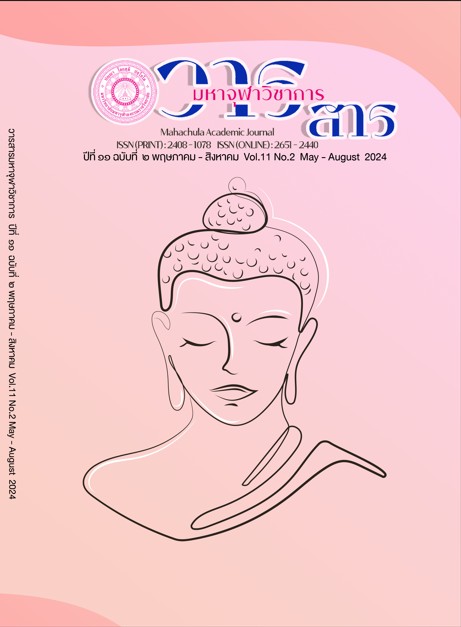The Effects of Organizing Mathematics Learning Activities Using Thinking Actively in a Social Context Wheel Model with Journal Writing on Mathematical Problem Solving and Connection Abilities of Mathayomsuksa 3 Students
Main Article Content
Abstract
The purposes of this research were to compare mathematical problem solving and connection abilities of Mathayomsuksa 3 students after obtaining organizing mathematics learning activities using thinking actively in a social context wheel model with journal writing with 70 percent criterion. The sample of this study was tested by 29 students in Mathayomsuksa 3/3 students in the second semester of the 2022 academic year at Thachana School. The instruments were 6 lesson plans, a mathematical problem solving ability test (with the reliability of .78) and a mathematical connection ability test (with the reliability of .88). The data were analyzed by arithmetic mean, standard deviation, and t-test for one sample.
The results showed that (1) The mathematical problem solving ability of Mathayomsuksa 3 students after obtaining organizing mathematics learning activities by using thinking actively in a social context wheel model with journal writing was higher than 70 percent criterion at .05 level of statistical significance and (2) The mathematical connection ability of Mathayomsuksa 3 students after obtaining organizing mathematics learning activities by using thinking actively in a social context wheel model with journal writing was higher than 70 percent criterion at .05 level of statistical significance.
Article Details

This work is licensed under a Creative Commons Attribution-NonCommercial-NoDerivatives 4.0 International License.
References
เกศินี เพ็ชรรุ่ง. "การพัฒนาชุดกิจกรรมการเรียนรู้ตามแนวการศึกษาคณิตศาสตร์ที่สอดคล้องกับชีวิตจริงเพื่อส่งเสริมมโนทัศน์และความสามารถในการเชื่อมโยงความรู้ทางคณิตศาสตร์". วิทยานิพนธ์ปริญญาครุศาสตรมหาบัณฑิต. จุฬาลงกรณ์มหาวิทยาลัย, ๒๕๕๖.
จุติภรณ์ เอียบสร้างกี้. "ผลของการจัดกิจกรรมการเรียนรู้คณิตศาสตร์ตามรูปแบบวงล้อการคิดอย่างกระตือรือร้นในบริบทเชิงสังคมและปัญหาปลายเปิดที่มีต่อความสามารถในการแก้ปัญหาและการคิดสร้างสรรค์ทางคณิตศาสตร์ของนักเรียนระดับชั้นมัธยมศึกษาปีที่ ๒". วิทยานิพนธ์ครุศาสตรมหาบัณฑิต. จุฬาลงกรณ์มหาวิทยาลัย, ๒๕๕๘.
ปริสา วงศ์คำพระ. "ผลการใช้รูปแบบการตั้งปัญหาเสริมด้วยกระบวนการแก้ปัญหาและการเขียนบันทึกการเรียนรู้ต่อความสามารถในการแก้ปัญหาและความสามารถในการเขียนทางคณิตศาสตร์ ของนักเรียนชั้นมัธยมศึกษาปีที่ ๖". วิทยานิพนธ์ครุศาสตรมหาบัณฑิต. มหาวิทยาลัยราชภัฏอุดรธานี, ๒๕๕๕.
ปรีชา เนาว์เย็นผล. การแก้ปัญหาคณิตศาสตร์ การพัฒนาทักษะการคิดคำนวนของนักเรียนระดับประถมศึกษา. กรุงเทพมหานคร: โรงพิมพ์จุฬาลงกรณ์มหาวิทยาลัย, ๒๕๓๘.
_______. "การจัดกิจกรรมการเรียนการสอนคณิตศาสตร์ โดยใช้การแก้ปัญหาปลายเปิดสำหรับนักเรียนชั้นมัธยมศึกษาปีที่ ๑". ปริญญานิพนธ์การศึกษาดุษฎีบัณฑิต. มหาวิทยาลัยศรีนครินทรวิโรฒ, ๒๕๔๔.
_______. “หน่วยที่ ๙ การแก้ปัญหาคณิตศาสตร์” ประมวลสาระชุดวิชาสารัตถะและวิทยวิธีทางคณิตศาสตร์. นนทบุรี: มหาวิทยาลัยสุโขทัยธรรมาธิราช, ๒๕๕๖.
วราภรณ์ มีหนัก. "การจัดการเรียนการสอนเพื่อพัฒนาทักษะและกระบวนการทางคณิตศาสตร์". วารสารวิชาการ, ปีที่ ๕ ฉบับที่ ๙ (กันยายน ๒๕๔๕) : ๕๘-๖๕.
เวชฤทธิ์ อังกนะภัทรขจร. ครบเครื่องเรื่องควรรู้สำหรับครูคณิตศาสตร์ หลักสูตรการสอนและการวิจัย. กรุงเทพมหานคร: จรัสสนิทวงศ์การพิมพ์, ๒๕๕๕.
สถาบันส่งเสริมการสอนวิทยาศาสตร์และเทคโนโลยี. ทักษะและกระบวนการทางคณิตศาสตร์. พิมพ์ครั้งที่ ๓. กรุงเทพมหานคร: บริษัท ๓-คิว มีเดีย จำกัด, ๒๕๕๕.
_______. ตัวชี้วัดและสาระการเรียนรู้แกนกลาง กลุ่มสาระการเรียนรู้คณิตศาสตร์ (ฉบับปรับปรุง พ.ศ. ๒๕๖๐) ตามหลักสูตรแกนกลางการศึกษาขั้นพื้นฐาน พุทธศักราช ๒๕๕๑. กรุงเทพมหานคร: สำนักงานคณะกรรมการการศึกษาขั้นพื้นฐาน กระทรวงศึกษาธิการ, ๒๕๖๐.
สมชาย วรกิจเกษมสกุล. "การพัฒนารูปแบบการสอนวิชาคณิตศาสตร์โดยการสื่อสารแนวความคิดเพื่อเพิ่มทักษะการแก้ปัญหา". วิทยานิพนธ์ปริญญาดุษฎีบัณฑิต. มหาวิทยาลัยศรีนครินทรวิโรฒ, ๒๕๔๐.
สิริพร ทิพย์คง. เอกสารคำสอนทฤษฎีและวิธีการสอนคณิตศาสตร์. กรุงเทพมหานคร: คณะศึกษาศาสตร์ มหาวิทยาลัยเกษตรศาสตร์, ๒๕๓๖.
อัมพร ม้าคนอง. ทักษะและกระบวนการทางคณิตศาสตร์: การพัฒนาเพื่อพัฒนาการ. กรุงเทพมหานคร: โรงพิมพ์แห่งจุฬาลงกรณ์มหาวิทยาลัย, ๒๕๕๓.
Bitter, G. Mathematics methods for the elementary and middle school : A Comprehensive Approach. Boston: Allyn & Bacon, 1990.
Krulik, S., and Reys, R. E. Problem Solving in School Mathematics: National Council of Teachers of Mathematics 1980 Year Book. Reston, Virginia: NCTM, 1980.
National Council of Teachers of Mathematics (NCTM). Principles and standards for School Mathematics. Reston, Virginia: NCTM, 2000.
Wallace, B. Teaching Thinking and Problem-solving Skills. Oxford: AB Academic Publishers, 2000.
Wallace, B., Maker, J., Cave, D., & Chandler, S. Thinking Skills and Problem-Solving an Inclusive Approach. London: David Fulton Publishers, 2004.
Wallace, B., Bernardelli, A., Molyneux, C., & Farrell, C. "TASC: Thinking Actively in a Social Context. A universal problem-solving process: A powerful tool to promote differentiated learning experiences". Journal of Gifted Education International, Vol. 28 no. 1 (January 2012): 58-83.
Zimmerman, R. "Problem Solving in a Complex World: Integrating DISCOVER, TASC, and PBL in a Teacher Education Project". Journal of Gifted Education International, Vol. 24 no. 2-3 (September 2008): 160-178.
สถาบันส่งเสริมการสอนวิทยาศาสตร์และเทคโนโลยี. ผลการประเมิน PISA ๒๐๑๘ : บทสรุปสำหรับผู้บริหาร. [ออนไลน์]. แหล่งที่มา: https://pisathailand.ipst.ac.th/pisa2018-summary-result/ [๒๙ พฤษภาคม ๒๕๖๖].
National Teacher Research Panel. How TASC (Thinking Actively in a Social Context) helped to ensure rapid school improvement. [Online]. Available: http://www.curee.co.uk/node/4788 [20 March 2019].


